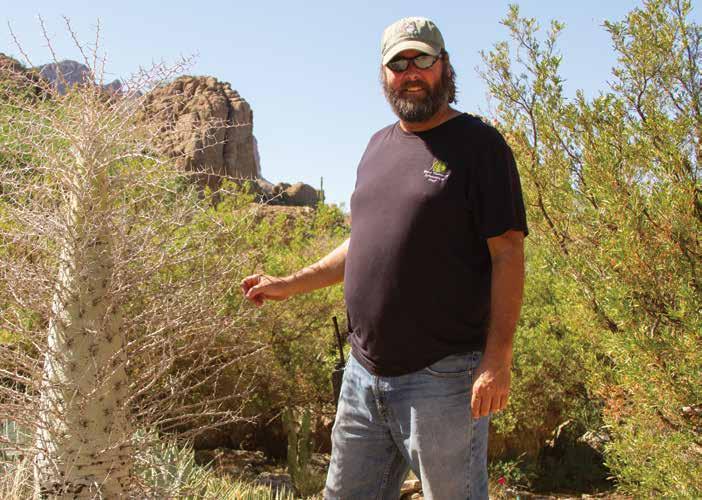
13 minute read
A Night in the Desert with Randy Babb
TEXT BY DARA HEWARD
Once the sun sets on our Arizona Deserts, the landscape completely changes to something otherwordly. AZGFD and BTA share similar goals showing just how amazing the desert is.
Advertisement
There is something special about the Desert as it is, but a beautiful, secret world awakens after the sun goes down. Once the sun sets on our Arizona landscape, the air becomes cooler and the flora and fauna put on a show. The night continues to cool until the sun rises again. With the air as dry as it is, there is very little moisture keeping the heat in. That’s why our Arizona nights can be so cold, but the daytime is still so hot and dry; with temperatures ranging from freezing to well over 100 degrees Fahrenheit.
Through thousands of years of evolution and natural selection, the flora and fauna of the desert have adapted to the intense summer heat and the barren, dry environment. How have they done this? Well, many species have adapted to avoid the high daytime temperatures and have developed the ability to be nocturnal or crepuscular (active at dusk or dawn). For instance, the many cactus species that are here at the Boyce Thompson Arboretum have learned to survive in this arid land by using adaptations which enable them to change the timing of their photosynthetic cycle.
Photosynthesis is the process in which plants collect carbon dioxide through holes in their leaves, called stomata, and convert it into usable forms of energy like sugar. How do plants change the timing of this cycle? Crassulacean acid metabolism (CAM) or CAM photosynthesis. Many cacti and succulents use this CAM process, instead of plants that use the C3 or C4 processes. CAM plants, like cacti, differ from other plants, in that the stomata only open during the cool hours after the sun has gone down. In this way, the cacti experience less water loss through transpiration. CAM plants such as cacti chemically fix organic acids and store carbon dioxide at night. When the sun rises, they are able to complete the photosynthetic process which requires light.

Arizona is known for its clear, dark skies meaning photographers flock here to capture the beauty of the heavens on camera. These Saguaros are under a blanket of star trails as the stars appear to circumnavigate the earth.
What if you’re a plant and you want to be pollinated, but you only bloom at night or at dawn? That’s where the nocturnal and crepuscular pollinators play a role. Once the day pollinators complete their work day, the night shift takes over. These pollinators include species like the Lesser Long-nosed Bats, Mexican Long-tongued Bats, the White-lined Sphinx Moth, the Tomato Sphinx Moth, and Yucca Moths. Blooming at night, from an evolutionary perspective, is a great solution to avoiding competition among showy, daytime bloomers.
As you can imagine, the local predators have also adapted to this night time activity, and night is when they come out to hunt. For example, bats do their flying under the stars. “Birds are on the day shift, bats are on the night shift, fighting the birds for similar resources. Bats have adapted to a nocturnal lifestyle to limit competition and to avoid predators, similar to owls and night hawks,” says Arizona Game and Fish Wildlife Viewing Program Manager and Wildlife Biologist, Randy Babb. He and I talked about the Desert, and how amazing it is at night. Arboretum members and I joined him at a bat netting night here at the Boyce Thompson Arboretum.
Randy’s program hosts the bat netting nights here, which is a great activity to draw our members out at night. Through these events, participants can learn about the desert and the local bat species that call it home. His program promotes wildlife viewing and conservation through these public or member events while subsequently conducting bat monitoring around the state. His goal is to teach people how to appreciate wildlife and nature. Here in the Arizona desert, a big part of the flora and fauna come out at night. Many people don’t get out at night, but that’s the time to be out in the desert! If you haven’t tried it, he highly recommends it.
According to Randy, “People say what they value, and they value what they know about.” That’s why it’s so important to educate people of all ages on our desert, both in the daytime and at nighttime. It’s part of our mission with The Boyce Thompson Arboretum: get out, educate, research, and conserve. We share many of the same goals as our partnering each night. It’s a whole secret world, another organizations, whether they’re state, federal, dimension. All you have to do is just go out and non-profit, or private. Like the Arboretum, look at it. It’s readily available to anybody, and the Arizona Game and Fish Department holds like so many of these things, you won’t see it programs to educate people, unless you are out at night. “to conserve and protect Arizona’s wonderful wildlife so we can all appreciate the I love being out listening to the amphibians calling I love being out listening to the amphibians calling, and enjoying the violent monsoon everyday magic of it.”
Randy helps achieve this goal by running a fantastic program and enjoying the violent monsoon showers and showers and lightning, or just standing outside under a starry sky and looking at and getting people out to see the desert while engaging safely with the wildlife. lightning, or just standing outside under a starry the milky way. There’s a lot of gratification in that kind of thing. I appreciate the solitude Just like many of us desert dwellers, Randy enjoys the sky and looking at the Milky Way. There’s a lot of and the whole beauty of the world at night. There’s a lot going on, and it’s wonderful solitude and the wildlife of gratification in that kind to be out there with it. Most the desert at night. “There’s a whole different world of thing. people don’t go out at night because they just have never [outside], while we’re sitting done it before. There’s nothing inside watching TV in our to be afraid of, it’s a great place houses. People don’t engage with it and people out there. There’s nothing trying to eat you or don’t know all this stuff is right outside their back get you, or anything like that. There’s a lot to door and these incredible stories are unfolding enjoy if you just take a few moments to do it.”

Karen Martin photographed this beautiful shot of an aloe at night during a night photography workshop that the Arboretum has here in the park. There’s endless possibilities when it comes to night photography.
Photo by Karen Martin

One of Randy Babb’s bat images, taken at the Arboretum, of a bat flying in the darkness. This is a Townsend's bigeared bat (Corynorhinus townsendii).
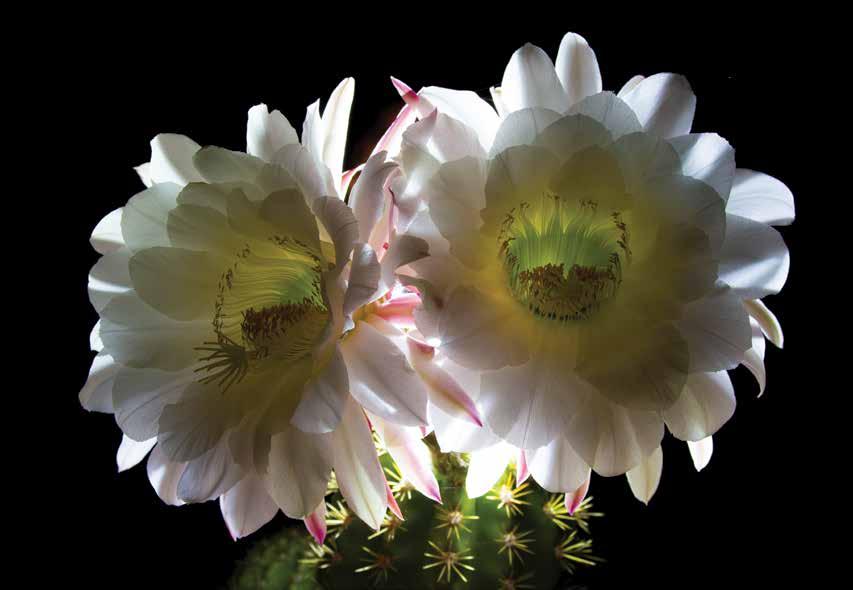
Dara Heward shot this night shot during late spring when many of the night-blooming cereus ceroid cacti are blooming at the BTA. This one is an Argentine Giant (Echinopsis candicans).

Scottsdale photographer Paul Landau has an eye for capturing the moon as well as many other things from hummingbirds to insects. He has mastered the art of photographing the microscopic world. For this image he used a DSLR body and a Schmidtt Casegrain telescope. It's 1/800 second shutter speed.
Pallid Bat
Scientific classification Kingdom: Animalia Phylum: Chordata Class: Mammalia Order: Chiroptera Family: Vespertilionidae Subfamily: Vespertilioninae Tribe: Antrozoini Genus: Antrozous Species: Antrozous pallidus
ABOUT THE PALLID BAT
Pallid bats are the most common bat we see here at the Boyce Thompson Arboretum. It is an extremely widespread species across Arizona. This bat is one of the two known bat species immune to scorpion venom and it’s the only bat species that catches the majority of its prey on the ground. They’ve been known to get caught in mouse traps because they hunt so close to the ground.
General Characters The pallid bat is distinguished from other bats by its large ears, large eyes, and light colored fur and white belly.
Habitat & Range Pallid bats are commonly found in arid regions and grasslands in the southwest United States from Canada to Mexico. They roost in small colonies in rocky outcroppings and are selective to picking places near water.
Diet
Pallid bats are predators of a documented 54 species of small vertebrates and invertebrates, including crickets, scorpions, centipedes, ground beetles, grasshoppers, cicadas, praying mantis, long-horned beetles, and even lizards and rodents.
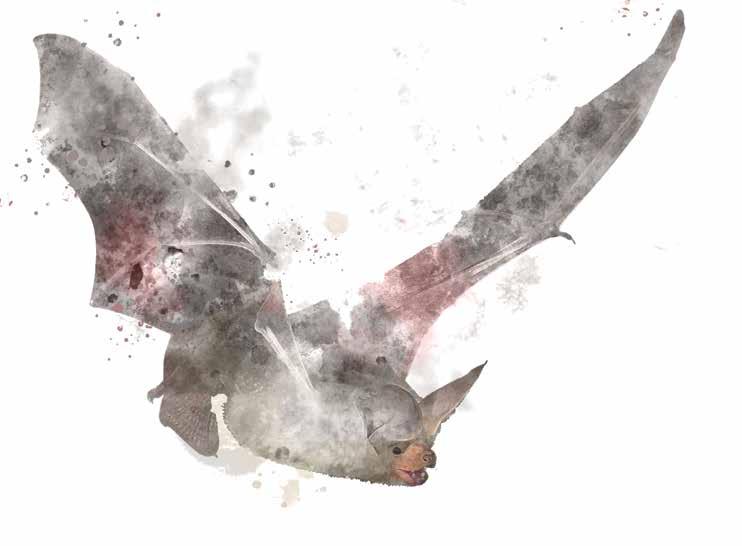
Conservation Status Common and of least concern, however, there is concern as Pallid bats are sensitive to human impacts on their natural habitats.
How You Can Help
Be a bat ambassador!
Reduce pesticides
Promote natural bat habitat
Avoid disturbing sensitive roosting areas
@robertlicano: #coopershawk #nesting #chick #boycethompsonarboretum #robertlicanophotography #nikonusa Photo by Robert Licano

@countyroadnine: When I snapped this picture of Elsie, it was just a cute little girl frolicking in the cutest children’s garden at the arboretum. Looking back at it now, it’s a perfect symbol of promises fulfilled. She’s my rainbow baby, travel buddy, and the perfect, spunky addition to our fam bam. Photo by Mikala Reiswig

@carynthomas33: All natural. Still on the bush. #rose #pink #pinkrose #boycethompsonarboretum Photo by Caryn Thomas

@biggirlveronica: Exploring Boyce Thompson Arboretumn and appreciating all the thriving plants since all I see are the ones struggling to stay alive back at my place.


@agnesartandphoto: Her skirt plus that light...match made in heaven. #vsco #engagement #agnesartandphoto #agnescouples #truelove #phoenixphotographer #arizonaphotographer #phoenixweddingphotographer #boycethompsonarboretum #anthropologie @anthropologie @ btarboretum @kimberlyk17 @devinsworld #liveauthentic Photo by Agnes Art & Photo
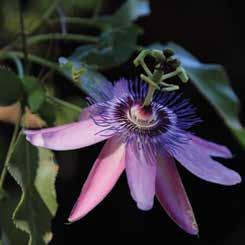
@azphotoandabroad: PASSION FLOWER Photo by David Levine @luxinthedesert: The Arboretum was absolutely beautiful yesterday. It rained the night before and brought the desert to life! . Photo by Melissa Carroll

@rogersterlingthecat: King of the jungle. #kingroger #superiorarizona #boycethompsonarboretum #boycethompson #arizonabeauty #catonaleash #graytuxedocat #adventurecatsorg #adventurecat #hikingwithcats Photo by Tracy Howell

Fare Thee Well! JIM REYNOLDS: A GREAT BOARD MEMBER
AND A GREAT HUMAN BEING.
Text by S. H. Sohmer
Jim Reynolds retired in 2007, after a very successful career as Director of Public Works in Northbrook, Illinois. Northbrook is a community over 100-years old and nestled in 13-square miles of the Chicago metropolitan area with over 33,000 dynamic, affluent, serviceoriented citizens. Jim managed a department of 58 full-time people, 4 permanent part-time staff, and 17 seasonal workers with an annual operations/ capital budget of more than $13.5 million. As the Director of Public Works for thirty years, he worked effectively with people from diverse ethnic, socio-economic and educational backgrounds, as well as with an excellent management team including the Village Manager’s office, Development, Planning, Engineering, Police, Fire, Finance, Public Relations, Human Resources, Information Systems, the Village Board and various commissions, as well as citizens, contractors and consultants. Blessed with common sense, insight, intuition, and a strong work ethic, his approach to problem solving is straightforward, honest, practical and service-oriented.
Jim had extensive FEMA/DHS emergency management training and deployments assisting public agencies. He was the Village’s most senior department head and administrator; he was responsible for the planning, care, maintenance, operation and repair of the Village’s diverse and aging infrastructure with a replacement value of hundreds of millions of dollars. This included: water production and distribution; sanitary and storm sewer collection/conveyance systems; streets including street lighting, signage, traffic controls, parkways, trees and sidewalks; buildings, grounds and commuter parking lots; snow and ice control operations; fleet/ heavy equipment maintenance; emergency and disaster preparedness and response; training and mentoring; and a host of other community support services.

All this experience allowed Jim to offer the Arboretum great leadership and vision during his service on the board which began in 2007, and soon included the position of Board Vice President. I would not have been at BTA without his strong support, and I benefited immensely from his wise judgement and counsel on many of the issues that needed mending at the Arboretum when I arrived. Jim and his wife, Kally, were among the first to welcome me to the Arboretum and even took my wife and I into their home for an extended stay when Hill House was under renovation. We could not have been made to feel more at home, right down to a sweet resident cat and the ‘book club of two’ that Sara and Kally immediately formed.
Now health issues require his resignation from the board. This must be a source of great regret for all those who have BTA’s best interest at heart. Leadership of such integrity, interest and ability is rare indeed.
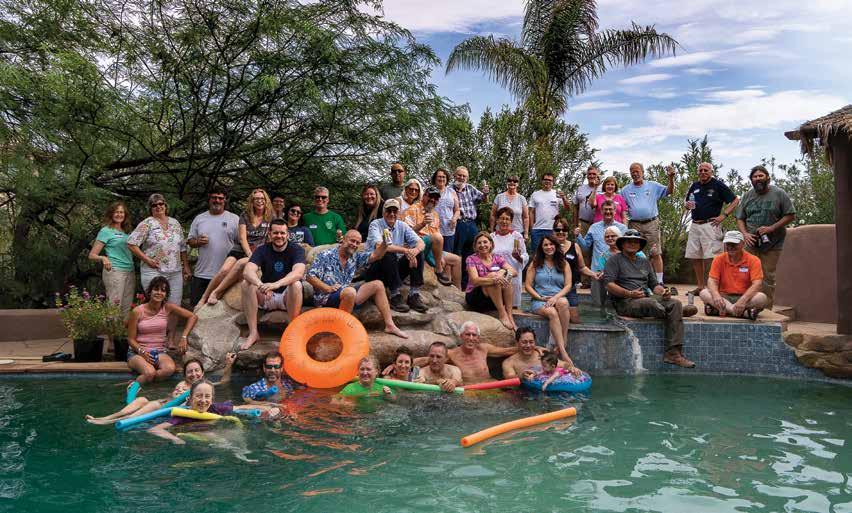
PAUL
¡ HASTA L A PRÓXIMA , AMIGO S !
Sue Tatterson captured this perfect moment from Paul Wolterbeek's going away party.
A note to BTA volunteers, members and friends I was unable to tell in person:
I’ve enjoyed talking with you in the gardens, and each time our paths crossed while out walking the main trail during my 18 years on staff. In July I was hired as communications manager for Gila County; I’m the ‘public information officer’ and media liaison – a new challenge, and a job that’s literally within walking distance of my home in Globe (our county seat!). If you’re unfamiliar with Gila County, it’s a slice of central Arizona with 4,796 square miles ranging from Sonoran Desert to ponderosa pine forests above 8,000 feet elevation –encompassing communities from Globe-Miami to Payson, Star Valley, Pine-Strawberry, Hayden and Winkelman. Gila County includes two of Arizona’s largest lakes (Roosevelt, San Carlos) and three separate Apache Nations: San Carlos, Tonto, White Mountain. Leaving BTA wasn’t an easy decision; I knew I’d miss the gardens, birds, lizards – and countless people who make the Arboretum unique. Leaving BTA, I keep with me a sincere gratitude for singular opportunities over the years – chances to meet and befriend some of Arizona’s premiere wildlife biologists; Grand Canyon State authors, painters and photographers who exhibited in the visitor center gallery - dedicated volunteers selflessly willing to share their time, energy and creativity. I’m thankful to all who shared of themselves to make BTA an enriching, inspiring environment – and staff who earned my respect taking risks to protect and preserve it. All who work at BTA are employed by the University of Arizona; I’m also appreciative of UA as an employer – among other things, for the courtesy of allowing me to retain use of my email, pwolterb@cals.arizona.edu, for those reading this who’d like to stay in touch, or contact me -- until we meet again!
Meet Joe!
Joe is our new General Maintenance Mechanic! He is from Mesa, Arizona and lives in Miami, Arizona. He is excited to be a part of the Boyce Thompson Arboretum team. One of his favorite things about the Arboretum so far is the people. He also loves that he gets to work close to nature, plants, and animals. On his third day of work he was lucky enough to see some Big Horn Sheep!
He has a black Labrador Retriever named Jack, who joins him on adventures and travels. Some of his hobbies are fishing, canoeing, karaoke, hiking, and music. An interesting fact about Joe is that he has made his own banjo. He apprenticed with Hickler Banjo Company in Mesa, Arizona and the White Mountains.
He is excited to get to work on the maintenance of the Arboretum. When asked how he wants to help Boyce Thompson Arboretum, he responded, “I want to be a good steward to the Arboretum and its history.”
Welcome to the Boyce Thompson Arboretum family, Joe!
A few facts about Joe:
FAVORITE ANIMAL?
IMPRESSIVE ARBORETUM PLANT?
